#andre nemec
Text
Teenage Mutant Ninja Turtles (2014)

2014’s Teenage Mutant Ninja Turtles marks the fifth time the heroes in a half shell appeared on the big screen. With this many strikes, I'm thinking it just can’t be done successfully. Certainly not as a live-action picture. This film’s characters are thin and uninteresting. Worse, there are so many of them they leave no room for any kind of clever plot. The attempts at humor fall flat and often make the film unintentionally creepy. Never mind the sometimes dodgy special effects. Combined together, they make Teenage Mutant Ninja Turtles feel like a trip to the sewers.
Reporter April O’Neil (Megan Fox) witnesses a group of mysterious assailants fighting back against the Foot Clan, a gang of ninjas terrorizing New York. Michelangelo (voiced by Noel Fisher), Raphael (voiced by Alan Ritchson), Leonardo (voiced by Johnny Knoxville) and Donatello (voiced by Jeremy Howard) are mutated turtles who grew up beneath the city and were taught martial arts by their “father”, an equally mutated rat named Splinter (voiced by Tony Shalhoub). Only by working together can they thwart The Shredder (Tohoru Masamune) and his minions.
This film was doomed the moment executives decided to make it live-action. With all of the technology director Jonathan Liebesman had at his disposal, the heroes previously created via rubber suits in the '90s are now computer-generated 8-foot-tall masses of muscle that just don’t fit in the real world. I know the sewer-dwelling heroes have brought many people joy since their creation but let’s not kid ourselves. They were created to be ridiculous and by failing to embrace this, writers Josh Appelbaum, André Nemec and Evan Daugherty will have you rolling your eyes. It would be too cartoonish for the turtles to be randomly named after Italian Renaissance painters so April named them as a kid. She also gave them their love of pizza. It would be too silly for Splinter to have learned martial arts from a human master so instead, he picked up his techniques from dirty books he somehow knew how to read. The attempts to clean up and make the story more realistic don't work. We paid to go see a movie named Teenage Mutant Ninja Turtles. We’re ready to suspend our disbelief and will gladly do so if the story is worth telling.
Even if you forgive the clumsy exposition, the characters are terribly written. All of the turtles are one-note. Raphael is angry and unwilling to follow the orders of his blue-bandanna-wearing brother, the one with the purple stuff is the nerdy one, and so on. If you didn't already know their names, you wouldn't bother to learn them. Then, we have Michaelangelo. Whenever he and April are on-screen together, he comments about how attractive she is. It’s supposed to be funny in a “he’s like a little kid crushing on the teacher” kind of way but you won’t laugh; instead, you’ll be scared we're about to witness a remake of Humanoids from the Deep. It isn’t just him; it’s also her useless co-star, played by Will Arnett. He’s 16 years older than she is. Seeing so many people slobbering at Megan Fox in this kind of movie makes you feel ill.
As bad as the heroes are, they're as complicated as a paper on astrophysics compared to the villains. The Shredder is a nothing of a character. He’s evil for evil’s sake, complete with a “let me kill my minions for kicks” attitude and an evil plan that makes NO SENSE. The only good decision made about the Turtles’ arch-enemy is to put him in an insanely futuristic suit of armor during the climax. Martial arts or not, there’s no way the character (who by my calculations, has to be at least 80) could stand a chance against the four giant, bullet-proof, radioactive reptiles with weapons. By making him a completely CG creation, it also helps make the carnage of their big fight somewhat believable.
I could go on and on about what doesn’t work in this film. Splinter’s creepy design and his unbelievable prehensible tail, the role William Fichtner’s Erick Sack’s plays in the story, the fact that draining a four-liter canister’s worth of blood from the turtles has no effect on them, April’s worthless reporting skills, the idea of an antidote to a virus that kills within minutes, the fact that - as a mutant - Splinter’s blood should contain the same mutagen as his children but for no explainable reason doesn’t, the fact that the turtles meant so much to April as a child she couldn’t even remember their names until she watched her own video diary, and the numerous plot holes throughout. Just about the only good thing about Teenage Mutant Ninja Turtles is a comedic scene during an elevator and a long chase down a mountainside that’s actually inspired. The rest is a big headache for anyone other than 12-year-olds who are hopped up on candy and soda. (June 4, 2021)

#Teenage Mutant Ninja Turtles#movies#films#movie reviews#film reviews#TMNT#Jonathan Liebesman#Josh Appelbaum#Andre Nemec#Evan Daugherty#Megan Fox#Will Arnett#William Fichtner#Danny Woodburn#Abby Elliott#Noel Fisher#Jeremy Howard#Pete Ploszek#Alan Ritchson#2014 movies#2014 films
2 notes
·
View notes
Photo
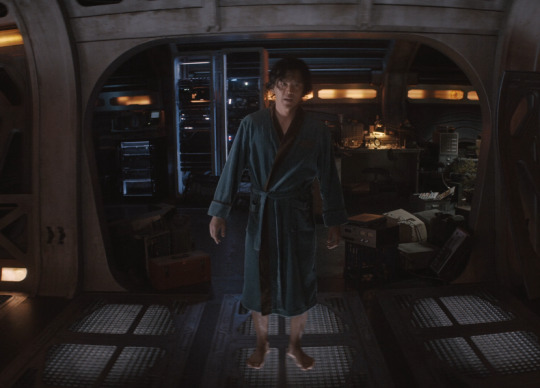
according to john cho in this bebop cast interview i just watched (at the vulture festival 2021) there was some discussion with andre nemec about whether or not spike would wear a robe (cus he has like. no clothes besides his suit) & they settled this robe that spike wears in darkside tango being “stolen from a hotel room” which i quite enjoy
#spike spiegel opportunist thief stealing a robe from a hotel room and a lighter from a woman he assumed to be pregnant#netbop posting#bebop tag#image
6 notes
·
View notes
Text
Cowboy Bebop (Netflix): Official Review
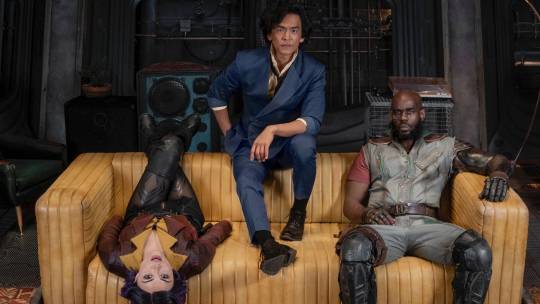
I’ve finished the first and only season of Netflix’s live-action adaptation of Cowboy Bebop. As a long-time super fan of the original anime, an illustrator, a writer, and an animation professor, I’ll do my best to account for everything I can.
This has spoilers for both the Netflix series and the original Anime
We’ll start with a quick star rating. For the tl;dr, scroll down to the “Overall” section at the bottom.
4/10 Stars
We’ll start with the more tangible elements: the explicit story. Then we’ll dive into the deep stuff: the philosophy that forms the narrative substructure of the series and how Spike’s dissociation (living in a dream) relates to that. Then we’ll talk about the good, the bad, and the end. Buckle up, cowboys.
THE EXPLICIT STORY:
Spike leaves the syndicate and asks Julia to come with him, but Julia is found out and is given an ultimatum by Vicious to either kill Spike or he’ll have them both killed. She doesn’t go to see Spike, and so he leaves the syndicate alone.
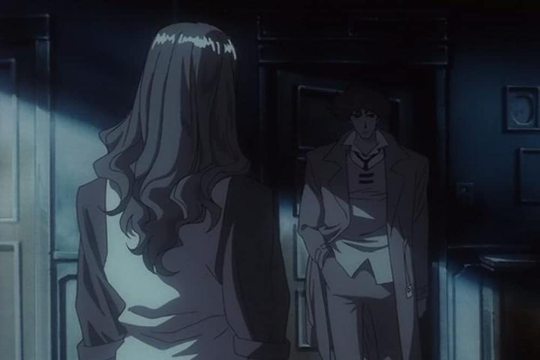
Vicious apparently doesn’t make good on that ultimatum, or is unable to kill Julia. The latter seems more likely, as that was the case with Spike, as well. There’s a bit of cat-and-mouse there. So Spike leaves for three years, and during this time he meets Jet and the two go bounding around as bounty hunters, eventually meeting Ein, Faye, and Ed. At some point, Spike had an accident, though--and this is extremely important, narratively. I’m not sure exactly when that happens chronologically in the story, and I may just be misremembering details. The point is, though, that he loses his eye and receives a false one. He says that in one eye he sees the past and in the other he sees the present.
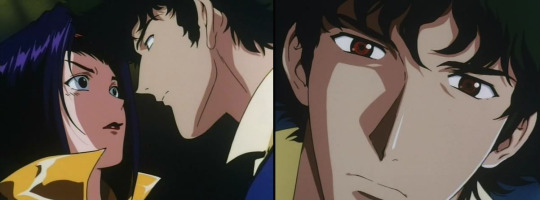
To briefly conclude the narrative notes, eventually Vicious tries to overthrow the elders of the syndicate, but it “fails” (not really). He’s captured and held prisoner, awaiting his execution. During this time, the elders send out hit men to take down anyone who has ever associated with Vicious and the “new guard,” so to speak. That includes Julia and Annie. The past catches up to Spike and Julia, and they’re brought back together to deal with their ties to the syndicate. Meanwhile, the second phase of Vicious’s plan kicks off, and he slaughters the elders, crowning himself its leader. Spike and Julia find Annie, watch her die, and resolve to take down Vicious. Julia dies in the process, and Spike faces off against Vicious. He “wins,” but is mortally wounded. And then...
“...bang.”

“Life is just a dream you know,
never ending...
I’m ascending...”
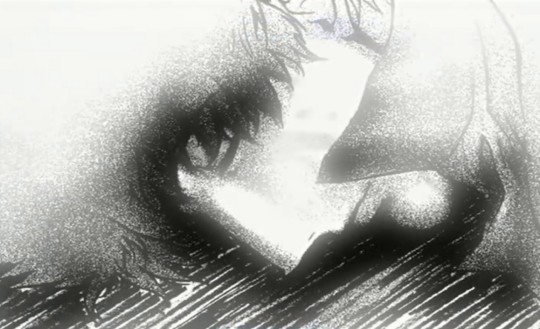
And then we all cry and sob like absolute babies, because the existential underpinnings are too much to bear. Right? Okay, so let’s dive into THAT, and why Nemec and the development team did NOT understand the assignment. What follows this is exploring precisely what the show’s essence was, and these are the things that Nemec and the development team either didn’t understand or didn’t respect--or both.
The Psychology and Philosophy: Themes of Nihilism and Absurdity
The themes of nihilism and absurdity run deep in Cowboy Bebop. I won’t make this torturous to get through--it’s pretty straight-forward, honestly. Spike loses his eye in a violent accident and starts seeing the past in one and the present in the other. He spends the rest of his life feeling like he’s in a dream. This theme of dreaming is the blood of Cowboy Bebop. It’s Spike dissociating and struggling to connect to reality after intense trauma and the despair of heartbreak, losing the one thing (person) he cared about--the thing he tells Jet that he had lost somewhere along the way. That’s what Julia was to Spike. She made him worthy of existing. So Spike spends three years completely unattached, and unable to attach to anything. This is his character and personality throughout the bulk of the series. We catch up to him at the beginning of the anime, but in the middle of his dream. The only thing keeping him connected to reality at all is the hope of seeing Julia again and learning that he isn’t just dreaming. He really isn’t sure if he died during that accident. He wakes up with a false eye and reality looks strange to him. Unfamiliar. But when Julia dies, that totem to reality is gone and he detaches completely.

He tries to explain to Faye why he has to face off against Vicious, but she doesn’t understand. He isn’t going there to die. He’s going there to find out of he’s really alive.

He’s going there for closure, and the only way to get that is to face Vicious. Vicious is the personification of nihilism in Cowboy Bebop.
“There is nothing to believe in. There is no need to believe.”
“There is nothing in this world to believe in.”
Spike, in his dissociative state, is living in absurdity. Unsure if he’s alive, if anything has any meaning, and yet he pushes forward.
“Whatever happens, happens.”

This is absurdity, in the philosophical sense. But it isn’t really enough for Spike. He’s willing to drift until something that ties him back to the reality he once knew strikes him. This is Julia, particularly. Even when it’s Vicious’s name that triggers him, it’s still in reference to Julia’s whereabouts. That is, until she dies. Then it becomes about waking up, and Vicious says multiple times that he is the only one who can kill Spike.
“I’m the only one who can keep you alive. And I’m the only one who can kill you.”
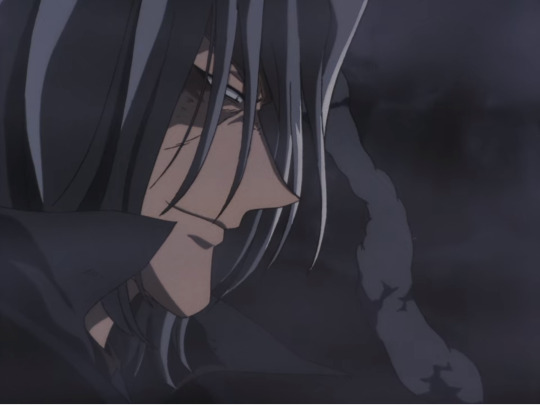
He’s the only one who can set Spike free. The only one who can wake him up from this dream. Death, for Spike, is closure. It’s the release from his hypnagogic post-accident existence. That hypnagogue is the landscape of transience that Cowboy Bebop exists within, as we catch up to the characters. That’s the space of the story that we’re introduced to. We’re on this transient journey with a found family who catch each other in passing as their pasts are catching up to them. Eventually they do, and each of them has to reckon with it. Jet understands this, which is why he doesn’t fight Spike’s decision. He’s an ex-cop, and he knows very well just how peoples’ past actions find them later, always. Spike has a reckoning, and nothing can stop it. And he has to face it.

So he goes to face off against Vicious so that he can wake up. He’s been suffering this dissociation for three years, and he needs to live again. He’s going there to live. To be set free.
That’s Cowboy Bebop. The dissociative disorder, the nihilism, the absurdity. It’s transient and tragic. It’s everything Nemec wanted to avoid, by his own words, and so he was destined to fail by any artistic measure of the story of Cowboy Bebop and what makes it significant. It’s a devastating exploration of lost human beings, and you cannot abandon that without collapsing Cowboy Bebop into something that can never be Cowboy Bebop. Nemec didn’t understand the assignment. He didn’t engage with the story at its depths--or if he did, he didn’t appreciate it and couldn’t respect it as a result.
Cowboy Bebop is more than a stylistic sci-fi western noir. It’s more than superficial fun and aesthetic appeal. It’s a pensive, dissociative, transient dream about a found family that was fated to merely cross paths. Netflix’s adaptation was destined to fail because it failed to engage with the story at its core--at its essence. Nemec didn’t have the wherewithal to accomplish the task. It seems to me that he was woefully ill-equipped as a critical storyteller to translate these elements into live-action. That’s all there is to it.
All right. Let’s talk about the Netflix adaptation a bit more, starting with what it does reasonably well.
THE GOOD:
To start, I’ll talk about what’s working. First, Yoko Kanno’s music is, as to be expected, the show’s biggest saving grace. There’s a fair amount of recycling from the original series, often updated somewhat for better or worse. When it’s not as good as the original tune, it’s still not bad, but often any issue with the music in this adaptation isn’t the song itself but the moments and manner in which they’re used--often feeling forced in like a wrong puzzle piece for the sake of nostalgia and to carry an otherwise poorly directed scene.
One standout performance is Mustafa Shakir, who does by FAR the best of the cast with his turn as Jet Black.
.
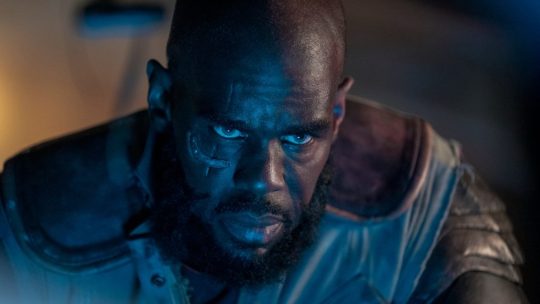
There are moments that are bad, but he does the best he can with what’s been given to him, and often he truly feels like he understood the assignment and channels Jet quite well. Another standout is Tamara Tunie as Ana, who plays a much bigger role in this adaptation than the character in the anime.
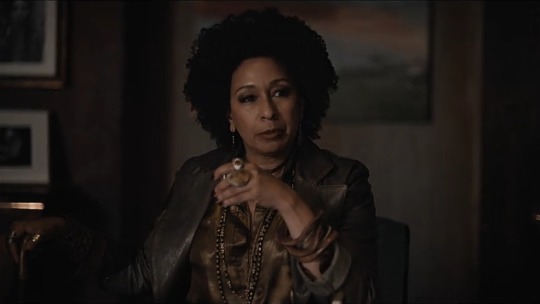
This was the most successful change made from the anime to live-action. Tunie brings dignity to an otherwise goofy, melodramatic adaptation--but we’ll get more into TONE later. Another smaller part that stood out to me as particularly memorable, given that he’s a totally new character, is A Martinez as Stax. This character didn’t need to exist in the series at all, but Martinez really sells the character and manages to bear gravity and menace which is sorely missing in the more important villains of the series; I’m looking at you, Vicious.
Ending the first season on Fallen Angels was a very good decision, in general. But that’s to say nothing of its execution, which I’ll get into later.
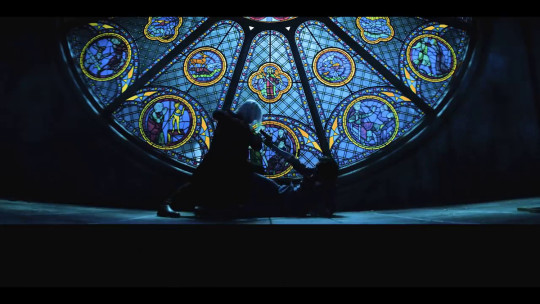
THE BAD:
We’ll start with the least bad and sort of go from there. Cho is an enjoyable actor, but he struggles as Spike. Sometimes he gets it, but much of the time he’s not able to carry the quiet, brooding, existential gravitas that the character is known for. He’s channeling a bit of the swagger and a lot of the goofball, but almost none of the menace that Spike is capable of, which was carried over from his syndicate days. This isn’t necessarily Cho’s fault, either--at least not entirely. This can also easily be laid at the feet of the writers and, in particular, the director. This adaptation only has a superficial understanding of nearly every aspect of the series, and their portrayal of Spike is no different. Spike has his endearing goofball moments, but this adaptation completely abandons his cold irritability when it comes to Faye, Ein, and Ed. They soften him far too much from the onset, rather than let that part of him develop over time. Whatever of Spike is jaded in this new series doesn’t play much in the foreground of his character, and when it does it’s not treated with the weight it deserves, but rather a highly-stylized, superficial, transparent narrative device that constantly reminds us that we’re watching a TV show--a TV show adapted from a particular pop culture icon.
Next, we’ll talk about Faye. Faye was done dirty as hell in this adaptation. She has a superficial entrance that shows all the flash and none of the substance, which is consistent throughout the season. This is Faye:

The real Faye, underneath the persona she keeps. We get none of this Faye. Instead, we get this Faye:
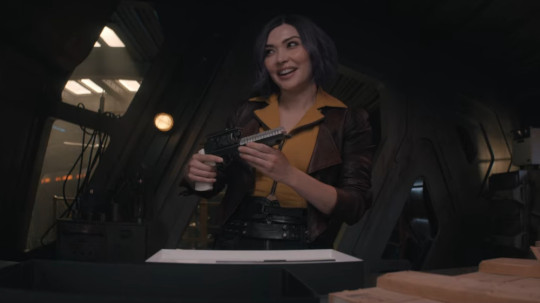
Daniella Pineda doesn’t hit the mark, and plays the character too much like a kitschy, fowl-mouthed teenager. Again, though, some of (perhaps most of) this must be laid at the feet of the writing and directing. This adaptation completely glosses over Honky Tonk Woman, which is an absolute travesty, and it sets the standard for how this adaptation denies Faye her dignity as a smooth operator with a lot more depth than she lets on. The fake mother backstory was atrocious. It shoehorned a glossy, comedy-driven history into a character who never gets her shot at being a real person. There’s a reason the most successful moments with Faye center around her witnessing pieces of the past she’s forgotten--it comes from the original anime and does a much better job exploring the character than any of the veneer that this adaptation paints over the weathered beauty of the original grain. While the lesbian encounter isn’t necessarily beyond conceivable for Faye’s character, this adaptation’s handling of it didn’t offer anything but an obligatory nod to inclusion, much like it’s random, superfluous, and at times gratuitous insertions of BDSM. And I say that as someone with an interest in that community, so it isn’t a prude dismissal of the practice, but a criticism of superficiality in storytelling. Faye wasn’t given the depth she deserved, and too much of her story was glossed over or abandoned for something much less substantial.
Julia. Another female character who was completely declawed and overacted.
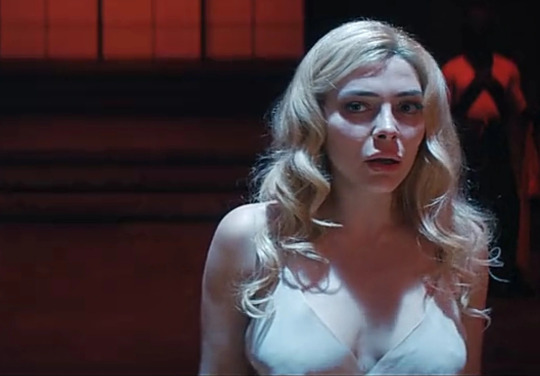
You might say, “But the end! She gets her claws!” Yeah, but they aren’t good claws. To be strong she had to become villainous? Not buying it, and it’s not Julia’s character. This adaptation turns Julia into a weepy, soapy damsel, with the intent of giving her an arc which finds her coming out of it strong. The problem is that her character’s arc isn’t consistent. There are episodes where she’ll go from somber damsel to murderous queen with very little provocation, and when she turns on Spike at the end it comes ENTIRELY out of left field. There was no narrative effort made to foreshadow her growing bitterness toward him, and so it feels like a tacked-on twist. And that’s being generous and entertaining the idea that this conceptualization of that triangular relationship is good at all, which I don’t believe it is. The whole situation feels polished and melodramatic, which the director mistakes for style. Julia should be like Spike--jaded and brooding; numbed by a life too long in the greyest moral landscape and surrounded by misery and death for the sake of power and control.

If they wanted to play her character the way they did, it would’ve been stronger to have her pursue the throne almost indifferently, not really knowing her own motivation other than to get out of her situation with Vicious. She should have a marked coldness, but with a dissonant drive to find meaning. She’s empty, but doesn’t know what else to do with herself. She’s drifting, just like Spike, in this dream world. They’ve dissociated to deal with the pain.
Vicious. Criminally over-acted. Again, this could just as easily be laid at the feet of the writing and directing rather than Alex Hassell’s efforts.
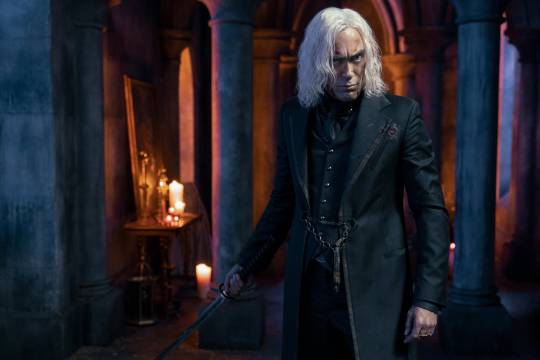
I don’t think Hassell was right for the part in general, but this adaptation absolutely eradicates the gravity of Vicious by injecting him with farcical melodrama and yet another weak backstory. He’s portrayed as a loose-cannon with major daddy issues, rather than the cold, calculating raptor that he is in the anime. If anything, Vicious should’ve been UNDER-acted by someone with an enthralling poker-face. When you look into his eyes, you should see nothing.

His motivation is to leave people devastatingly, inexorably face-to-face with their own profound weakness. He is a mercilessly precise psychoanalyzer, and a blade straight to the heart of what makes us fearful about ourselves--the beast, the shadow, perfectly adapted for survival against a meaningless world of dreams. This adaptation forces Vicious to his knees, often literally, completely unable to control himself. The exact opposite of the character’s true nature.
Gren. I don’t have too much to say about Gren, other than I feel they robbed another character of their dignity and weight.

Gren shouldn’t have showed up in this first season. He should’ve arrived in the second season and his story should’ve been kept in tact. He wasn’t trans. His character was a veteran of the War on Titan, and when he was betrayed by his old comrade, Vicious, he became so depressed that he was given an experimental drug which increased his estrogen levels, causing him to grow breasts. Making him trans didn’t offer anything to the character, though Park’s portrayal isn’t without its charm, and I do think they could’ve played the character better. When Park is able to take the character down to earth, they shine much better than the superficial pageantry that defines too much of the character in this iteration. Showrunner Andre Nemec (upon whom I place the majority of blame for this turnout) said in an interview with Entertainment Weekly,
"Gren does not have a good history of becoming a nonbinary character. [It's] dark and didn't feel like the story that I thought was important to tell," Nemec explains. "I never wanted Cowboy Bebop to be a picture of a dystopian future. I wanted it to be nostalgic, but also hopeful. People, I believe, always find their ground, and a way to excel — to live in a better world. A person being nonbinary isn't a discussion. It's just a fact."
source: https://ew.com/tv/cowboy-bebop-mason-alexander-park-gren-nonbinary/
So it becomes clear here that Nemec never had any respect for the tone of the original series to begin with, and Gren’s character alterations were little more than a way to shoehorn in a superficial modern conception of who the character SHOULD be in an idealized iteration of Cowboy Bebop as Nemec himself wanted it, not as it masterfully existed. And it should be remembered, on that point, that Gren may not have been explicitly trans, but he WAS explicitly gay. Nemec would’ve done well to acknowledge that it wasn’t his job to judge the series and build something he thought was morally better, but rather his job was to understand the series at its depths and call forth its essence into reality with good faith and dignity. Instead, he completely abandons the most important aspect of the series: the TONE.
THE TONE:
You cannot tackle a series like Cowboy Bebop--you cannot adapt it in any other form--without first fully understanding and respecting its tone.
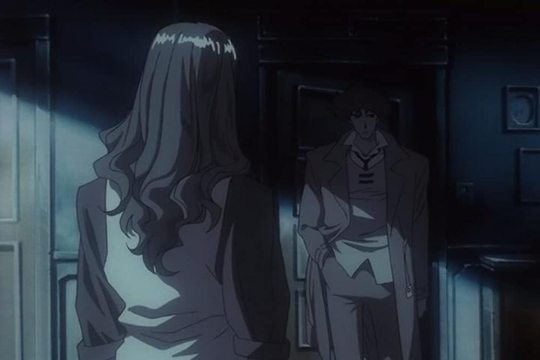
Cowboy Bebop (anime) is a bittersweet noir at its core. It is thoughtful, brooding, and existential--even a bit absurdist. But that doesn’t mean it’s grim. On the contrary, it’s absurdism comes out in the playfulness of its jaded characters. Spike isn’t hopeless, he’s unattached.
“Whatever happens, happens.”
“I try not to think.”
He says that, but its only the persona that allows him to slip in and out of any situation without risking attachment. He saves the dog (Ein). He trains Roco. He even empathizes with Vincent, and sees himself and probably even Vicious in that character. He knows what war and violence does to a person, and his spirit lives in understanding for them. He lives as an absurdist, but he has faith (or, at minimum, curiosity) in spirituality. Let’s not forgot the wonderful character of Laughing Bull, which the live-action adaptation completely does away with, to its peril.
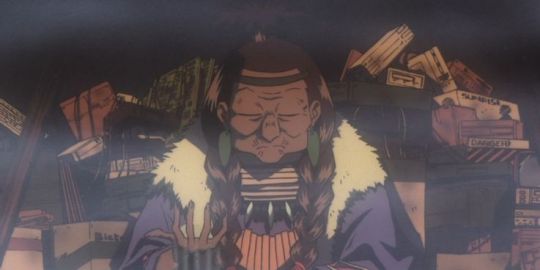
Laughing Bull is a part of that hopeful, sweet-in-the-bittersweet nectar of Cowboy Bebop’s tone. What parts of Bebop are bright aren’t without their depth, because the levity is grounded in irreverence most often, with the wonderful exception of Ed, who shines like a supernova and cuts straight through the grit. She’s the perfect counterbalance.
But back to that bittersweet tone, there are elements of the series which define it that Nemec either didn’t grasp or didn’t respect enough to maintain. Too much backstory is shoehorned in, and every backstory is a disastrous farce compared to its supposed inspiration. Jet’s family is superfluous. Faye’s fake mother is a cringe-inducing joke. God only knows what they’re going to do to Ed, who actually has one of the more cohesive backstories, ironically enough. The anime was all about TRANSIENCE.

The backstories of these characters came in fleeting flashes as they reminisced about their lives before the dream began. They all felt as though they’d already lived their better lives, and in the wake of the collapse of those lives they’ve been living in a dream defined by ennui and mourning. They’re living day to day, moment to moment, and slowly the whiff of family begins to collect again around this ragtag team of bounty hunters. But it can’t last, because everyone’s past comes back to collect in one way or another. They’re released from the dream of the Bebop, and just as quickly as their stories merged, they diverged once again and all were on their way.

That transience is given stylistic lip service in this live-action adaptation, as much of the story’s deeper elements are--if they exist at all for Nemec’s unfaithful interpretation. Nemec didn’t understand the assignment. He was the wrong man for the job.
The directing was atrocious. An absurd amount of canted angles. Overdramatizing fish-eye close-ups.

Rickety choreography (although Spike’s eradication of the Neptune gang is a standout shot). The acting was campy, as though the director and showrunner assume that any adaptation from an animated series must have a superfluous quality to it--which is another example of not understanding the assignment. The cinematography, among a host of other style elements, seemed hell-bent on robbing the story of any gravity and dignity it may have had and supplanting it with insubstantial style and pageantry. This effort is an insult not only to the characters and the story, but to the spirit of the music which gives the show its soul. There was no dignity to this adaptation. I keep going back to that, but it’s so incredibly important, and its the smoking gun of a failed assignment. You cannot tackle a series like Cowboy Bebop--you cannot adapt it in any other form--without first fully understanding and respecting its tone. The tone is the whole spirit of a show like this.
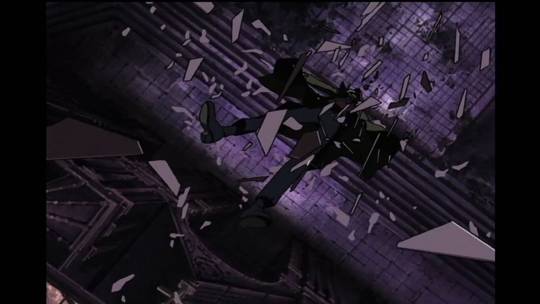
It is the single most defining aspect of the work, and if you do not do your homework and engage with it deeply and emotionally so that you come out of it with a sense of responsibility rather than viewing it as an established name within which you can inject your own narratives, then you will deservedly, devastatingly fail. This series is a caricature of Cowboy Bebop, not an adaptation of it. It is a cursory understanding, if that, of the series as a whole. Watanabe voiced concerns that his consulting role was little respected, and those concerns turned out to be absolutely justified. They didn’t seem to want Cowboy Bebop. They wanted an established vehicle for a highly stylized Netflix venture.
RADICAL EDWARD:
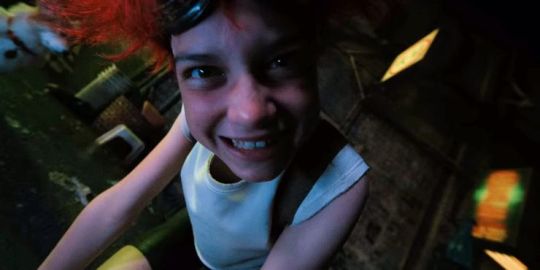
There is but one victim here, and that is Eden Perkins, who was shamefully shredded over scarcely a minute of their debut as Radical Edward--which they probably hoped would be their break-out role. But instead, this thirteen year-old kid, who was very excited to have the opportunity to play such a fantastic character, was poorly directed and eviscerated by strangers, now without the opportunity to prove themselves any better. The show was cancelled, leaving Perkins to wade through all the criticism for the shortest and most impactful role of their life. What an absolute tragedy, and shame on the people who willfully disconnected themselves from the kid so they could get some heavy blows in for fun. Criticism is one thing, but the cruelty deserves a thorough, merciless shaming.
If Perkins ever reads this, don’t let it get you down. Stand back up and move forward to the next thing. This doesn’t have to be your bitter swan song. You were failed by those who adapted it. You never had a chance. It wasn’t fair.
THE END:
I think it was a good decision to end the first season on Fallen Angels, and that episode has strong moments. The fight between Vicious and Spike actually turned out better than I expected, and the dialogue in the key moment was kept well, and even delivered pretty decently. Aside from that, the Julia twist was an absolutely nauseating disaster of a decision.

A terrible idea born out of a misguided effort to concoct a culturally appealing evil queen out of a character who didn’t deserve that sort of treatment. It wasn’t properly developed, the moment came as a profoundly unwelcome surprise, and its intended narrative purpose--to end the season with Spike having no one left--is heavily overshadowed by its tone-deaf attempt to establish as many hard-ass female characters as it can manage. The story already had them, but this adaptation has no understanding of what made them so.

Instead, it opts for more pageantry that isolates us from the characters rather than drawing us in toward their depths. It understands characters as icons, not people. Insofar as it understands them as people, they only mimic personality. They don’t embody the suffering of real people. The anime used down-to-earth dialogue and character development to bring a stylized sci-fi noir down to reality, with little gushing over its own superficial appeal. Netflix’s adaptation uses style as a stand-in for depth of character development and story. It spends a lot of time developing bad character stories where the original anime could poetically tell many, many character stories with precisely chosen vignettes to much greater artistic effect. Where the anime’s attention to detail was esoteric and understated, the Netflix adaptation takes every opportunity to flash itself to us, and the details are all superficial nostalgia.
OVER ALL (TL/DR):
This adaptation takes in the original anime superficially. It sees the style and denies the value of the substance, instead opting to supplant it with its own far less intuitive, far more superficial restructuring of the characters and story. It shoehorns in terrible expansions and reimaginings of the characters’ stories, which completely decimates the intimacy of the dysfunctional ragtag family unit of the Bebop crew. It attempts to regain this with saccharine throw-away lines and a complete misunderstanding of the value of hope in the context of this series, which only comes to this crew in relation to the bitter pasts which showrunner Andre Nemec (pictured below) vocally denied the value of--but which gives that hope weight rather than just shallow platitude. He wanted the series to be hopeful rather than dystopian, completely missing the fact that it isn’t dystopian--it’s noir. Mars is a thriving place, as are multiple places the crew finds themselves. It’s their world which is cold and hypnagogic. Their personal worlds. The lives they’ve led.
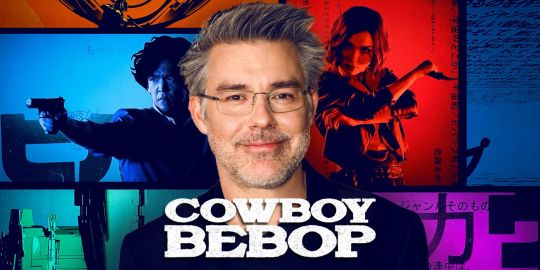
More than anything else, this adaptation abandons the most important aspect of the series: the tone. It doesn’t engage in the story at its depths of psychology or philosophy, which is the only way to understand the profound value of it. They sacrificed substance for style, and threw out its meaningful struggles in favor of poppy, kitschy, edgy fluff. It doesn’t respect the source material, which Watanabe himself complained of in regards to his tertiary role as a consultant--which only seems to be credited as an obligation and for disingenuous credibility, despite Watanabe’s vocal concerns about how little his opinions seemed to be valued in adapting Cowboy Bebop. Read a quick note about that here:
https://comicbook.com/anime/news/cowboy-bebop-live-action-netflix-anime-creator-comment/
The series is an unfaithful failure in the final analysis. Yoko Kanno, Mustafa Shakir, and Tamara Tunie did what they could, but it couldn’t fix a bad faith adaptation.
Looking forward to owning the new music, though.
See you, space cowboy.

#cowboy bebop#netflix#netflix cowboy bebop#andre nemec#spike spiegel#faye valentine#jet black#review#criticism#critique#show review#gren cowboy bebop#ana cowboy bebop#john cho#mustafa shakir#daniella pineda#alex hassell#elena satine#a martinez#tamara tunie#shinichiro watanabe#anime#cowboy bebop canceled#cowboy bebop netflix canceled#canceled
250 notes
·
View notes
Video
youtube
Cowboy Bebop Trailer
Cowboy Bebop follows bounty hunters Spike Spiegel, Jet Black, and Faye Valentine. The crew is “ready to hunt down the solar system’s most dangerous criminals — for the right price. But they can only kick and quip their way out of so many scuffles before their pasts finally catch up with them.” (via Netflix)
Cowboy Bebop stars John Cho, Mustafa Shakir, Daniella Pineda, Alex Hassell, and Elena Satine. André Nemec serves as showrunner and an executive producer. Shinichirō Watanabe, the director of the original anime, is onboard as a consultant on the series. Original composer Yoko Kanno has also returned for the live-action adaptation.
Cowboy Bebop hits Netflix on November 19, 2021.
#cowboy bebop#live action cowboy bebop#john cho#mustafa shakir#daniella pineda#alex hassell#elena satine#andre nemec#shinichiro watanabe#yoko kanno#netflix#spike spiegel#jet black#faye valentine#TGCLiz
46 notes
·
View notes
Text
Cowboy Bebop Gets Companion Books and a Comic Series to Go with its Live-Action Netflix Release
Cowboy Bebop Gets Companion Books and a Comic Series to Go with its Live-Action Netflix Release #Comics #CowboyBebop
Titan Publishing has announced a new collaboration with Netflix to publish the official fiction, non-fiction, and comics for the eagerly anticipated upcoming series, Cowboy Bebop, set to premier on Netflix on November 19 2021. A prequel novel to be published in November 2021 will be followed by a beautiful coffee table art book detailing the making of the series in Spring 2022. These will also…

View On WordPress
#andre nemec#artgerm#comic books#Comics#cowboy bebop#cowboy bebop: a syndicate story: red planet requiem#cowboy bebop: making the netflix series#cowboy bebop: the comic series#dan watters#lamar mathurin#netflix#sean cummings#stanley lau#titan publishing#tomorrow studios
26 notes
·
View notes
Text
Cowboy Bebop: Why can’t Hollywood make reboots work?
Cowboy Bebop: Why can’t Hollywood make reboots work?
tl:dr; Too many factors are completely different and “Hollywood” has a chaotically short attention span.
Obviously, that answer isn’t helpful, but that’s also the point. Without enough context, the “too long; didn’t read” doesn’t tell you enough about the question stated in the title of this post. You can make inferences, but without more insight into the real problem(s) there will be no clear…

View On WordPress
4 notes
·
View notes
Text
Cowboy Bebop Netflix Release Date Set for November 19, Eight First Look Photos Unveiled
Cowboy Bebop Netflix Release Date Set for November 19, Eight First Look Photos Unveiled
Cowboy Bebop now has a release date — November 19 — and first look courtesy of Netflix, with the streaming service unveiling eight photos starring its three leads: John Cho (Harold & Kumar) as Mars-born bounty hunter with a past Spike Spiegel, Mustafa Shakir (Luke Cage) as ex-cop bounty hunter Jet Black who has a cybernetic arm, and Daniella Pineda (Jurassic World: Fallen Kingdom) as mega-in-debt…

View On WordPress
#andre nemec#christopher yost#cowboy bebop netflix#cowboy bebop netflix release date november first look live action cast john cho cowboy bebop#cowboy bebop release date#daniella pineda#hajime yatate#john cho#mustafa shakir#Netflix#shinichiro watanabe#yoko kanno
0 notes
Text
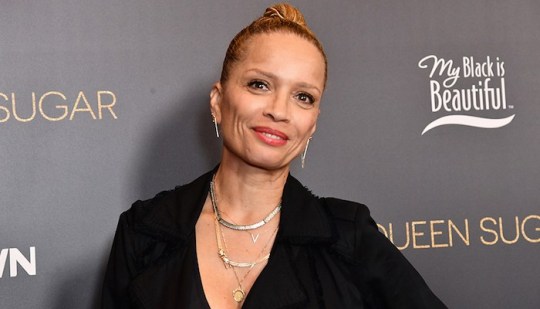
KILL THEM ALL: Victoria Mahoney Will Make Big-Studio Debut With Graphic Novel Adaptation http://filmbk.me/RXsTc7
0 notes
Text
Paramount mette in cantiere un nuovo spin-off della saga G.I. Joe
Paramount mette in cantiere un nuovo spin-off della saga G.I. Joe
Continua l’espansione della saga legata ai mitici G.I. Joe e, dopo uno spin-off dedicato a Snake Eyes, è tempo di un film d’insieme.
Il The Hollywood Reporter ha riferito che Paramount Pictures ha incaricato Josh Appelbaum e Andre Nemec (sceneggiatori di Mission: Impossible – Protocollo Fantasma) di scrivere una sceneggiatura dedicata ad un nuovo spin-off della saga G.I. Joe.
La fonte…
View On WordPress
0 notes
Text
Movie In Development: Beverly Hills Cop 4
Movie In Development: Beverly Hills Cop 4
Movie: Beverly Hills Cop 4
Release: Unknown
Genre: Action/Comedy
Note: “The movie will be released on Netflix.”
Writers: Josh Appelbaum, Andre`Nemec, Daniel Petrie, Jr.(characters).
Directors: Adil El Arbi, Bilall Fallah
Starring: Eddie Murphy
Sources: https://blackcinemaconnection.com/rumoredannounced-titles/
https://www.nme.com/news/netflix-sign-make-beverly-hills-cop-4-2574594?amp
View On WordPress
#act#Adil El Arbi#Andre` Nemec#Beverly Hills Cop 4#Bilall Fallah#comedy#Daniel Petrie Jr.#Eddie Murphy#Josh Appelbaum#King-Galaxius#King-Galaxius Stravinsky#Movie In Development: Beverly Hills Cop 4#Netflix
0 notes
Text
Wonder Park (2019)

On the upside, Wonder Park isn't riding on some TV show, video game or other pre-established property to appeal to kids. It’s a gentle, colorful and energetic film. Is it anything special? Not really. It's content going through the motions for the most part. Still, the children who see it will be entertained.
June Bailey (voiced by Brianna Denski) and her mother (Jennifer Garner) stretch their creative muscles when they expand the imaginary amusement park Wonderland, a place whose insane rides are maintained by a group of talking animals: boar Greta (Mila Kunis), twin beavers Gus (Kenan Thompson) and Cooper (Ken Jeong), neurotic porcupine Steve (John Oliver), narcoleptic bear Boomer (Ken Hudson Campbell) and monkey Peanut (Norbert Leo Butz). When June’s mother becomes gravely ill and must go away to be treated while dad (Matthew Broderick) sends June to summer camp to keep her mind from the family drama, the young girl runs away, only to stumble into the real-life Wonderland which is now in a state of disarray and overrun by chimpanzombies.
The film has a nice message of nurturing imagination and following your dreams, of teamwork and perseverance. It’s easy for any film on this topic to be wholesome but I’m not going to criticize Wonder Park for this. Not when the final product looks this good. If you’re going to see this animated picture, make sure it's in 3D as there are many scenes where characters fly through the air, the camera dives through roller-coaster loopy-loops, and stuff comes right at ya. The plot moves quickly, keeping the visuals interesting and some of the rides featured are just so crazy you have fun simply watching them.
Although the troubled production (Paramount fired the director due to multiple complaints of inappropriate and unwanted behavior and their name is nowhere to be seen in the credits) might’ve had something to do with the finished quality, you get the feeling Wonder Park just wasn’t put through the ringer during the writing phase enough times to be more than a second-rate animated children’s film. It isn’t bad but this isn’t going to be anyone’s favorite down the line.
Wonder Park (odd name considering the place June goes to is called WonderLAND) is essentially a lesser version of Inside Out, The NeverEnding Story, or even - to a certain extent - The Wizard of Oz. You’ve seen the story before, and better. If your kids are screaming to go see it and you want to take the family out instead of watching a classic (superior as it may be), it’s not so bad. (3D Theatrical version on the big screen, March 16, 2019)

#wonder park#wonder park movie review#wonder park review#wonderpark#josh appelbaum#andre nemec#Robert gordon#Brianna denski#ken Hudson campbell#kenan thompson#ken jeong#mila kunis#John oliver#Jennifer garner#Matthew broderick#2019 movies#2019 films#3 star movies#3 star movie reviews#adamwatchesmovies#inside out#the wizard of oz#The NeverEnding Story
9 notes
·
View notes
Text
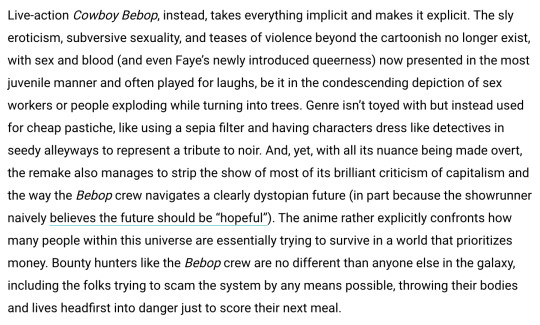
this review is so good and sums up everything... the audacity of director andre nemec saying pseudo-progressive nonsense like "julia and faye's stories better reflect the kind of storytelling around women that audiences have come to expect" in an interview about differences between the remake and original. as if a) bebop wasn't written by a woman (nobumoto keiko) and b) he hadn't fundamentally misunderstood everything about the power of julia being an ambiguous ghost that haunts spike because his whole damn arc is about how he can never be free from his past and the power of faye being a sexy flirty loser, a lazy slob, and a flop of a con artist.
73 notes
·
View notes
Photo
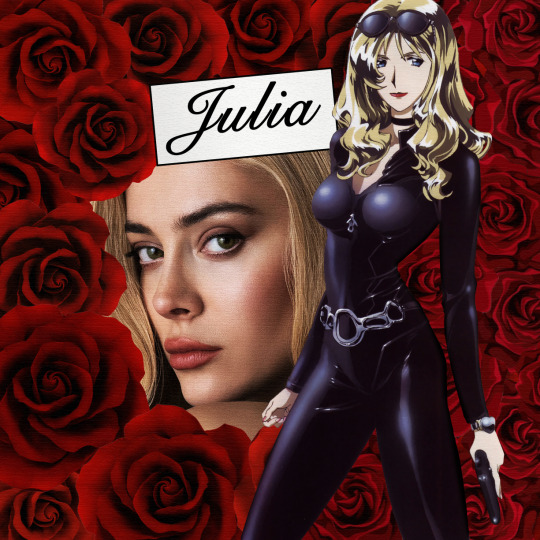
“If you asked Vicious, he’s the aggrieved party. Spike Spiegel’s the villain. I think it’s important to be able to understand a little bit of that perspective and it’s as important to me, to tell the story of Julia. Being able to give that character her own agency, by which she controlled her own destiny and to some degree, didn’t need to be rescued by anyone. She was going to rescue herself.” -Andre Nemec (Cowboy Bebop 2021, Showrunner)
#cowboy bebop#netflix cowboy bebop#julia cowboy bebop#spike spiegel#spike x julia#vicious cowboy bebop#netflix#julia#spike#vicious
19 notes
·
View notes
Text
Netflix Drops First Images of Live-Action “Cowboy Bebop”

Netflix has dropped the first images of its live-action Cowboy Bebop series. Cowboy Bebop stars John Cho as Spike Spiegel, Mustafa Shakir as Jet Black, and Daniella Pineda as Faye Valentine. André Nemec series as showrunner and an executive producer. Shinichiro Watanabe, the director of the original anime, is onboard as a consultant on the series.
Cowboy Bebop follows Spike Spiegel, Jet Black, Faye Valentine, and Radical Ed, a “rag-tag crew of bounty hunters on the run from their pasts as they hunt down the solar system’s most dangerous criminals. They’ll even save the world…for the right price.” (via Netflix)
Cowboy Bebop hits Netflix on November 19, 2021.
(Image via Netflix Twitter)
#cowboy bebop#netflix#john cho#mustafa shakir#daniella pineda#spike spiegel#jet black#faye valentine#andre nemec#shinichiro watanabe#TGCLiz
10 notes
·
View notes
Text
G.I. Joe's Chuckles To Feature In A Paramount Picture
G.I. Joe’s Chuckles To Feature In A Paramount Picture
Somehow, this is not an April Fool’s prank.
According to The Hollywood Reporter, Mission: Impossible — Ghost Protocol writers Josh Appelbaum and Andre Nemec have been commissioned by Paramount and Hasbro to write a screenplay featuring the G.I. Joe character “Chuckles.”
We don’t recognize him, either.
The character debuted in the 1987 line of figures and made his comic book debut in G.I. Joe #60…
View On WordPress
0 notes
Text
[:en]REVIEW: Everything Sucks! Couldn't Describe the Show Any Better[:]
[:en]REVIEW: Everything Sucks! Couldn’t Describe the Show Any Better[:]
[:en]If I had to choose, I’m probably more a ’90s kid.
Despite possessing a genuine love & appreciation for all things 1980s, having spent ages 7-17 entrenched in the decade that brought us America Online, the Taco Bell dog and a misguided big screen adaptation of Wild Wild West, my kinship with the ’90s is strong, defining and one which very much remains a part of who I am today. Though it…
View On WordPress
#1980s#1990s#80s#90s#America Online#Andre Nemec#Bill Clinton#Boring High School#Boring#Crystal Pepsi#Everclear#Everything Sucks#Everything to Everyone#Freaks and Geeks#Full House#Jolt Cola#Josh Applebaum#Little Earthquakes#Oregon#Reel Big Fish#Roseanne#Stranger Things#Surge#The Wonder Years#Tori Amos#VHS#Wild Wild West#Zima#2018#Netflix
0 notes